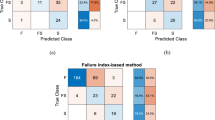Abstract
In order to apply the performance-based seismic design, an engineer must first find out whether the column is expected to fail in shear before or after flexural yielding. According to column failure characteristics and failure mode of reinforced concrete column, the UW-PEER structure performance database was discussed and analyzed. In order to investigate the relevance of failure mode and factors such as longitudinal reinforcement ratio, transverse reinforcement ratio, hoop spacing to depth ratio, aspect ratio, shearing resistance demand to shear capacity ratio and axial load ratio, Fisher’s discriminant analysis (FDA) of the above factors was carried out. A discriminant function was developed to identify column failure mode. Results show that three factors, i.e., V p/V n, hoop spacing to depth ratio and aspect ratio have important influence on the failure mode. The failure mode has less to do with longitudinal reinforcement ratio, transverse reinforcement ratio and axial load ratio. Through using these three factors and the model proposed, over 85.6% of the original grouped cases were correctly classified. The value of coefficient of V p/V n is the largest, which means that discriminant equation is most sensitive to the shearing resistance demand to shear capacity ratio.
Similar content being viewed by others
References
DEIERLEIN G G, KRAWINKLER H, CORNELL C A. A framework for performance-based earthquake engineering [C]// J A BLUME. Pacific Conference on Earthquake Engineering. Stanford, 2003, 140–148.
LAO Xiao-chun, HAN Xiao-lei. Performance index limits of high reinforced concrete shear wall components [J]. Journal of Central South University of Technology, 2011, 18: 1248–1255.
LIU Ming, LU Ben-yan, LIU Bo-quan. Failure mode identification method of reinforced concrete bridge pier [J]. China Journal of Highway and Transport, 2011, 24(3): 58–63. (in Chinese)
LAM S S E, WU B, WONG Y L, WANG Z Y, LI C S. Drift capacity of rectangular reinforced concrete columns with low lateral confinement and high-axial load [J]. Journal of Structural Engineering, 2003, 129(6): 733–742.
MAEKAWA K, AN X. Shear failure and ductility of RC columns after yielding of main reinforcement [J]. Engineering Fracture Mechanics, 2000, 65(2/3): 335–368.
LI Hong-nan, XIAO Shi-yun, HUO Lin-sheng. Damage investigation and analysis of engineering structures in the Wenchuan earthquake [J]. Journal of Building Structures, 2008, 29(4): 10–19. (in Chinese)
ACUN B, SUCUOĞLU H. The effect of displacement history on the performance of concrete columns in flexure [J]. Advances in Performance-Based Earthquake Engineering, 2010, 13(3): 373–382.
ASCE/SEI 41-06. Seismic rehabilitation of existing buildings [S]. American Society of Civil Engineers: Reston, Virginia, 2007.
FEMA 356. Prestandard and commentary for the seismic rehabilitation of buildings [S]. American Society of Civil Engineers, Reston, Virginia, 2000.
ZHU L, ELWOOD K J, HAUKAAS T. Classification and seismic safety evaluation of existing reinforced concrete columns [J]. Journal of Structural Engineering, 2007, 133(9): 1316–1330.
BERRY M, PARRISH M, EBERHARD M. PEER structural performance database user’s manual (Version 1.0) [R]. CA: University of California: Berkeley, 2004.
WAN Hai-tao, HAN Xiao-lei, JI Jing. Analyses of reinforced concrete columns by performance-based design method [J]. Journal of Central South University (Science and Technology), 2010, 41(4): 1584–1589. (in Chinese)
Update to ASCE/SEI 41 concrete provisions, seismic rehabilitation of existing buildings [S]. American Society of Civil Engineers: Reston, Virginia, 2007.
SEZEN H, MOEHLE J P. Shear strength model for lightly reinforced concrete columns [J]. Journal of Structural Engineering, 2004, 130(11): 1692–1703.
DU Zhi-min, JIN Xin-qiao. Multiple faults diagnosis for sensors in air handling unit using Fisher discriminant analysis [J]. Energy Conversion and Management, 2008, 49(12): 3654–3665.
TAN Chao, CHEN Hui, WU Tong. Classification models for detection of lung cancer based on nine element distribution of urine samples [J]. Biological Trace Element Research. 2011, 142(1): 18–28.
Author information
Authors and Affiliations
Corresponding author
Additional information
Foundation item: Project(2011ZA05) supported by the State Key Laboratory’s Autonomous Project of Subtropical Building Science in South China University of Technology
Rights and permissions
About this article
Cite this article
Qi, Yl., Han, Xl. & Ji, J. Failure mode classification of reinforced concrete column using Fisher method. J. Cent. South Univ. 20, 2863–2869 (2013). https://doi.org/10.1007/s11771-013-1807-1
Received:
Accepted:
Published:
Issue Date:
DOI: https://doi.org/10.1007/s11771-013-1807-1



